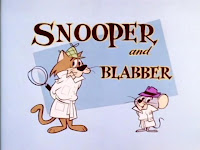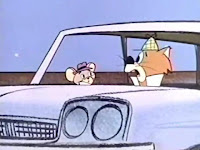Cartoon voice artistry is an awe-inspiring talent. Who doesn’t admire the abilities of the people who were part of one’s childhood—Mel Blanc, Daws Butler, June Foray, Bill Scott, Paul Frees and so many more? Growing up, I loved listening closely to cartoon voices and enjoyed picking out who was responsible for them. I was pretty good at it, too. But there were a few snags, thanks to a lack of credits on the cartoons. For example, I—like jillions of others around the world—believed Mel Blanc did all the voices (that weren’t June Foray) on the Warner Bros. cartoons. After all, the cartoons said so. It wasn’t until early adulthood before I learned, thanks to other childhood fans who had grown up to become cartoon detectives and authors, there had been a fellow named Arthur Q. Bryan. He was not Mel Blanc. But he was Elmer Fudd. The cartoons lied.
 To your right, you see a couple of Hanna-Barbera characters who got to mouth the words of the great Mike Maltese. Everyone knows that Daws Butler and Don Messick supplied the main voices for all the early characters, and that Daws filled the larynxs of both Snooper and Blabber.
To your right, you see a couple of Hanna-Barbera characters who got to mouth the words of the great Mike Maltese. Everyone knows that Daws Butler and Don Messick supplied the main voices for all the early characters, and that Daws filled the larynxs of both Snooper and Blabber.Afraid not.
 If you watch any of the first four Snooper and Blabbers—‘Puss N’ Booty’, ‘Switch Witch’, ‘Real Gone Ghosts’, and ‘Desperate Diamond Dimwits’, you’ll notice Blabber sounds different. OK, then it must be Don Messick. He got all the other major roles, right? And this version of Blabber kinda sounds like he’s in Don’s vocal range, so it must be him.
If you watch any of the first four Snooper and Blabbers—‘Puss N’ Booty’, ‘Switch Witch’, ‘Real Gone Ghosts’, and ‘Desperate Diamond Dimwits’, you’ll notice Blabber sounds different. OK, then it must be Don Messick. He got all the other major roles, right? And this version of Blabber kinda sounds like he’s in Don’s vocal range, so it must be him.Except it isn’t.
 You may not recognise the middle character to your right. He’s Aloysius, the Puss who had the Booty. And you may not recognise his voice. But you can tell it’s neither Butler nor Messick. Nor is the Maudie Frickert-like falsetto of the title character in ‘Switch Witch.’ You can tell—especially in ‘Desperate Diamond Dimwits’—it’s whoever is voicing Blab.
You may not recognise the middle character to your right. He’s Aloysius, the Puss who had the Booty. And you may not recognise his voice. But you can tell it’s neither Butler nor Messick. Nor is the Maudie Frickert-like falsetto of the title character in ‘Switch Witch.’ You can tell—especially in ‘Desperate Diamond Dimwits’—it’s whoever is voicing Blab. So who is it?
Fortunately, there are still cartoon detectives out there revealing the presence of long-forgotten radio actors in animated films (Arthur Q. Bryan’s main employment was on Fibber McGee and Molly). And the successful sleuths in this caper are a couple of fine cartoon writers named Earl Kress and Mark Evanier, neither of whom I’ve had the pleasure of meeting, though I read Mark’s blog and we were part of the same conversations on Usenet from time to time back when people read Usenet.
Some time ago, Earl surprised me with an internet forum post identifying Peter Leeds’ voice on at least one Quick Draw McGraw cartoon (Leeds worked with Stan Freberg, as did Daws). I pressed my luck and asked about the Aloysius voice. Whether Earl was on the trail before that, I don’t know, but I raised the question again not long ago on another forum, and Mark weighed in with the answer:
The first four Snooper & Blabber cartoons were recorded (probably all in one day) by Daws Butler and Jerry Hausner. For reasons unknown, Hausner was replaced as Blabber...and thereafter, Daws did both leads and they brought in other actors (most often, Messick) to do the other parts in those cartoons. Earl Kress and I figured this out. We were stumped for a time by the "other" Blabber voice. Hausner did most of his voice work for U.P.A. where he was also the voice director but he occasionally turned up in other places.Later, Mark went on to give a little history about the H-B recording sessions in the late 1950s:
Daws got a certain fee. Everyone else got scale. So if they did a Snooper & Blabber with Daws as Snooper and Hausner as Blabber, the voice budget was Daws's fee plus one scale payment. And then if they later did a Snooper & Blabber with Daws as both characters plus Don Messick in incidental roles, the voice budget was Daws's fee plus one scale payment.So who was Jerry Hausner? As Mark mentioned, he was at U.P.A.; Boxoffice magazine reveals on March 21, 1960 that studio head Steven Bosustow appointed him dialogue director. But he was there long before that. He originated the voice of Waldo on Ragtime Bear, the first Mr. Magoo cartoon in 1949. Magoo himself, Jim Backus, revealed in a 1976 interview with the Associated Press that Waldo was supposed to be the star. But Hausner suggested a voice that Backus had tried out on the Edgar Bergen radio programme would be perfect for Magoo. Backus’ character stole the show, and instead of being getting a starring role and fame, Hausner found himself playing supporting U.P.A. characters—the nadir one possibly being a best-left-forgotten Chinese stereotype houseboy in those cheap and lame made-for-TV “Mr. McGloo” cartoons.
 Hausner excelled in radio, but he was rarely a series regular. Radio was full of top actors who were constantly in demand and went from show to show. They weren’t part of the cast every week, but were called back frequently; Mel Blanc, Frank Nelson, Bea Benaderet and Joe Kearns on Jack Benny’s show are good examples. Hausner was among them. His first regular role seems to have been on the Mutual network show Barrel of Fun in 1941 also featuring Verna Felton, Sara Berner, Harry Lang and Charlie Ruggles, who all later did cartoons. He went overseas in World War Two and ended up in Japan on Armed Forces Radio with Hans Conried. He often appeared on dramas, too, especially Suspense and Lux Radio Theatre, and anthologies like The Cavalcade of America. But his specialty was an imitation of a crying baby, which he pulled off on a number of top radio comedies, including Benny’s and My Favorite Husband. The latter starred Lucille Ball and was produced by Jess Oppenheimer, who cast him as Ricky Ricardo’s agent in the pilot of I Love Lucy. The role was intended to be a regular one, but then Oppenheimer decided to try different secondary characters—a couple named Fred and Ethel—and Hausner was downgraded to a semi-regular at $70 an appearance, and walked off the show for good in 1954 when Desi tore into him in front of the cast and crew over a technical problem that ruined a scene (and wasn’t his fault).
Hausner excelled in radio, but he was rarely a series regular. Radio was full of top actors who were constantly in demand and went from show to show. They weren’t part of the cast every week, but were called back frequently; Mel Blanc, Frank Nelson, Bea Benaderet and Joe Kearns on Jack Benny’s show are good examples. Hausner was among them. His first regular role seems to have been on the Mutual network show Barrel of Fun in 1941 also featuring Verna Felton, Sara Berner, Harry Lang and Charlie Ruggles, who all later did cartoons. He went overseas in World War Two and ended up in Japan on Armed Forces Radio with Hans Conried. He often appeared on dramas, too, especially Suspense and Lux Radio Theatre, and anthologies like The Cavalcade of America. But his specialty was an imitation of a crying baby, which he pulled off on a number of top radio comedies, including Benny’s and My Favorite Husband. The latter starred Lucille Ball and was produced by Jess Oppenheimer, who cast him as Ricky Ricardo’s agent in the pilot of I Love Lucy. The role was intended to be a regular one, but then Oppenheimer decided to try different secondary characters—a couple named Fred and Ethel—and Hausner was downgraded to a semi-regular at $70 an appearance, and walked off the show for good in 1954 when Desi tore into him in front of the cast and crew over a technical problem that ruined a scene (and wasn’t his fault).Considering his experience with Mr. Arnaz, Hausner might have been perfect for the role of Baba Looey. But he wasn’t at Hanna-Barbera by then. Mark and Earl haven’t found out why he left the studio after being handed a regular character and supporting work.
 Hausner had a long and varied television career—including five episodes of The Dick Van Dyke Show and three of Green Acres and an obscure show called Valentine’s Day—that you can read about on the occasionally-dubious Internet Movie Database.
Hausner had a long and varied television career—including five episodes of The Dick Van Dyke Show and three of Green Acres and an obscure show called Valentine’s Day—that you can read about on the occasionally-dubious Internet Movie Database.James (Jerry) Bernard Hausner died on this date in 1993 at age 83 in Los Angeles, so it’s only fitting we remember the occasion by paying tribute to a radio and cartoon voice actor forgotten by many.

VERY belated, but not only Jerry Hausner was in Valentine's Day, but a lovely lady who also did radio/cartoon voices who should be very familiar: Janet Waldo.
ReplyDeleteI still remember that one Flintstones Jerry did, and it's maybe the only HB he did, "Dino Disappears", Season 4, Episode 3, where Hausner played an Ed Wynn-like vaudevillian who owned a fake Dino (one of those episodes aimed at those not too kind on Pebbles as the storytline had Dino resentful and jealous of Pebbly Poo and leaving.) The preceding one was "Groom Gloom", with the aforementioned Miss Waldo making an early non-Jetsons guest voice on the 'Stones (the teenage Pebbles dream Fred had). Hausner, in animation, of course will be best known for UPA's Waldo, Mr.Magoo's young adult goofy nephew..(Daws Butler did the voice for a while there..)SC (And outside the timeframe DePatie-Freleng revived Mr.Magoo and his nephew but only Jim Backus, a longtime friend of Hausner, returned, Casey Kasem played Mr.Magoo's rather "slow-thinking" nephew as a smart character).
And of course Elliott Field has been since confirmed as Blab's voice.
ReplyDelete